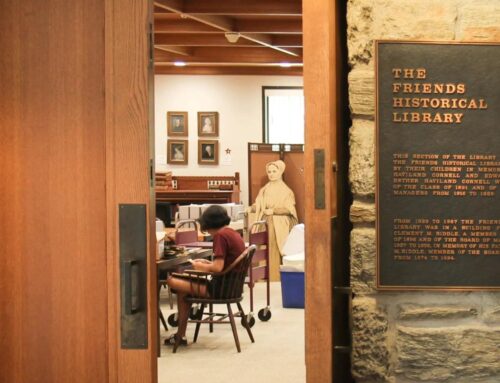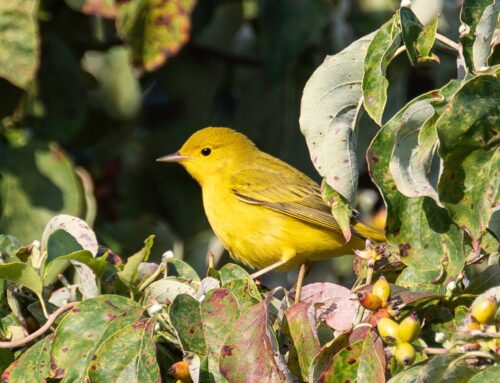PA Master Naturalist’s Notebook: June 3-17, 2024

As the Program and Tour Coordinator at Tyler Arboretum, every week I look forward to preparing my weekly report for our volunteer educators.
I draw upon my training as a PA Master Naturalist to highlight the plants, insects, animals and other natural phenomena I’ve recently observed on Tyler’s grounds. I include photos (and some videos) along with educational tidbits our volunteers can share with our visitors.
My colleagues have encouraged me to compile my weekly reports into a biweekly blog for you. Here’s what caught my attention at Tyler Arboretum for the weeks of June 3 and 17, 2024. I’d love to hear from you about your observations too! Please email me anytime at tmallon@tylerarboretum.org.
Report: June 3, 2024
There are four hatchlings in the robin’s nest on the back porch at Stonehouse. Both parents are very attentive and have been observed bringing food to the nest and carrying away the hatchlings’ waste. Platter-sized snapping turtles have been sunning themselves at the pond. Let’s hope one of them comes and lays eggs at the Pollinator Preserve again this season.
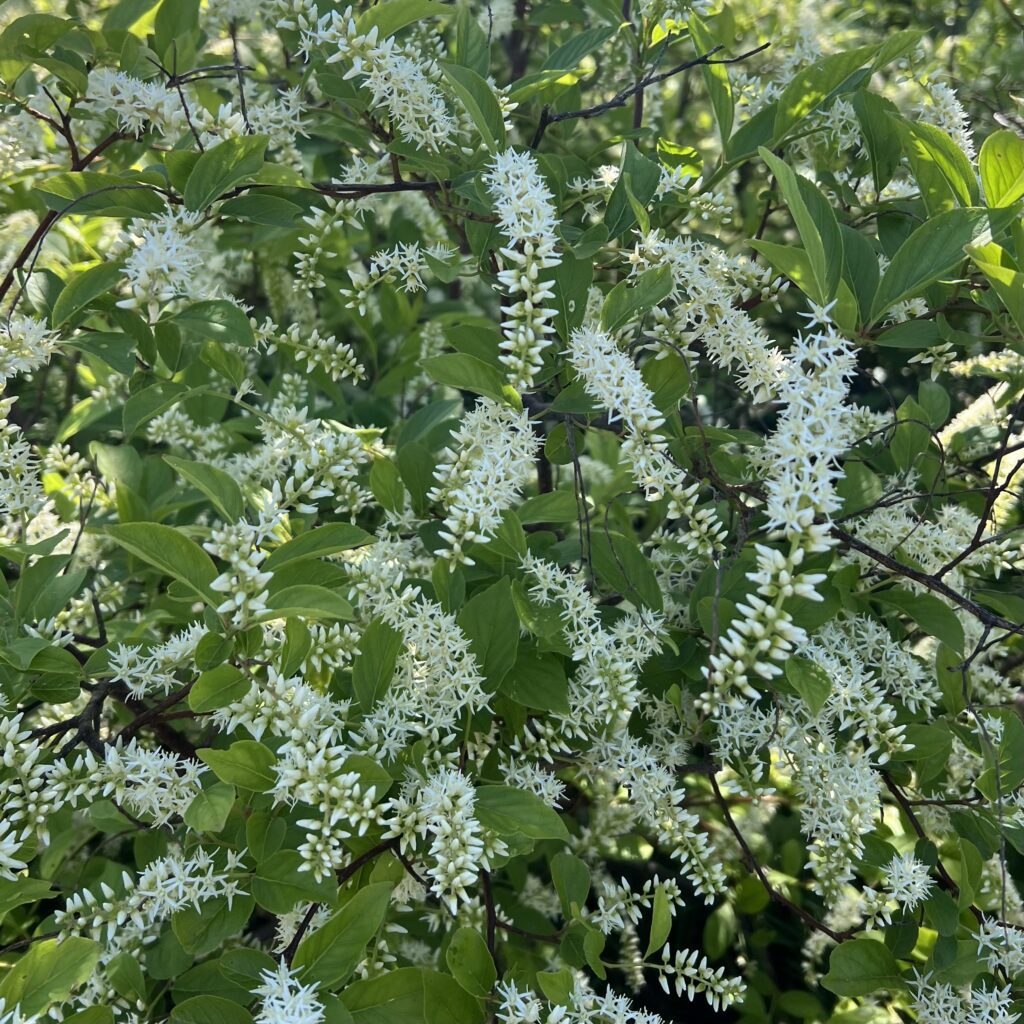
Virginia sweetspire (Itea virginica)
It was abuzz with pollinators on Saturday morning!
Location: End of the Visitor Center path.

Mountain laurel (Kalmia latifolia)
Look closely and you will see that mountain laurel flowers are spring loaded. The anthers (pollen carrying part of the flower) are held in the creases of the flower. This protects the pollen from rain and wind. As the flower opens the tension on the filament increases. When a bumblebee lands on the flower, its weight triggers the anthers to spring out of the pockets and dust the bee with pollen. Check out the unusual looking flower buds. The little bumps around the center of the bud are the developing anthers.
Location: Pennsylvania’s state flower can be found just past the door to the barn restrooms.

Smoke tree (Cotinus coggygria)
This tree is native to Asia and Europe.
Location: Top of Fragrant Garden.
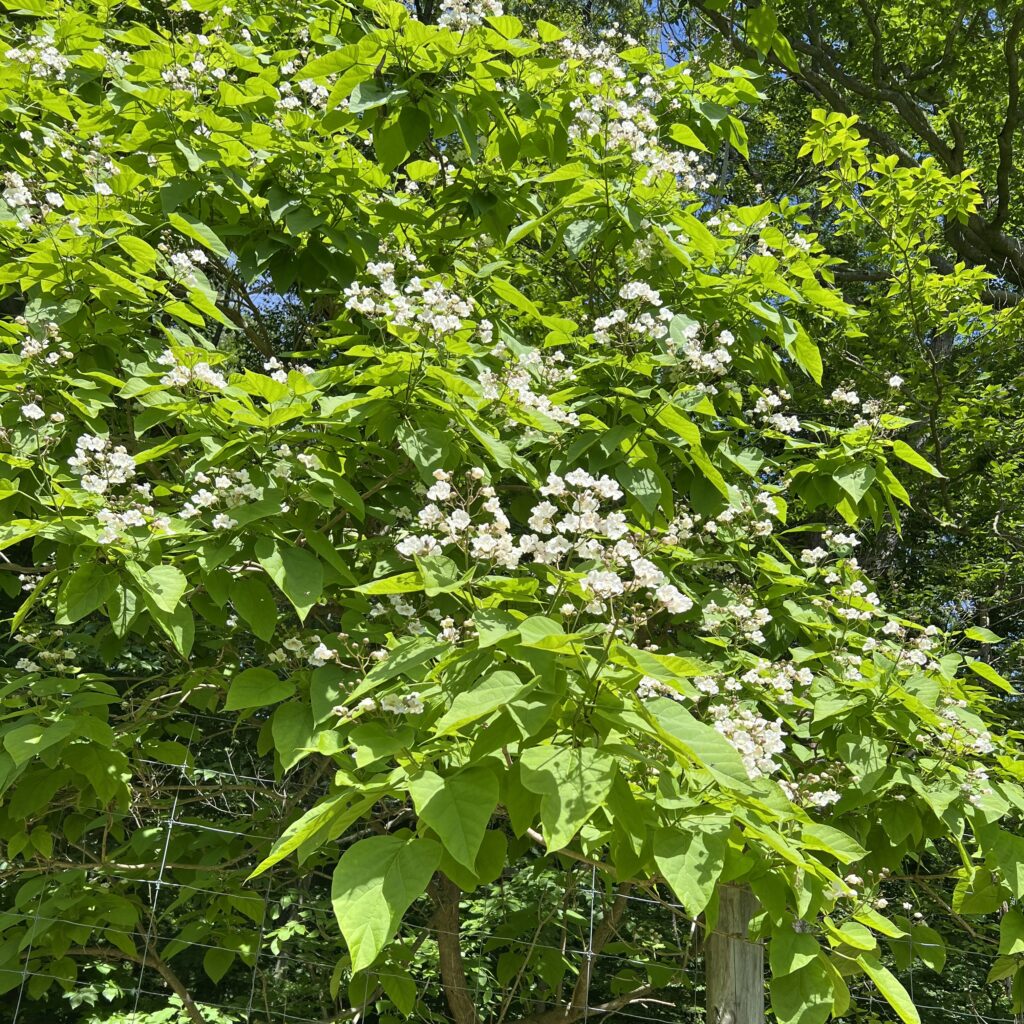
Catalpa trees
The catalpa trees are blooming. There are two growing outside the deer enclosure fence that can be viewed from Lucille’s Garden. One is behind the rain garden. The taller one can be seen from the strawberry patch. Northern and southern catalpas look similar but the northern has larger leaves, flowers and seed pods. My best guess is that these are northern catalpas (Catalpa speciosa).
Viewing location: Lucille’s Garden.

Red-banded hairstreak (Calycopis cecrops)
As the season progresses, it’s common to see these butterflies with torn and tattered hindwings. Hairstreaks move their hindwings up and down when resting. That movement, coupled with the eye spots, fools predators into mistaking the hindwing for the butterfly’s head and attacking there. The wing tears away, the butterfly escapes and the predator does not get a meal. While this leaves the butterfly looking rather bedraggled, it does not appear to affect its ability to fly.

Blue-eyed grass (Sisyrinchium)
This small native flower is blooming now along meadow edges. It is a member of the iris family and can spread enthusiastically in a garden setting.
Report: June 17, 2024
As the weather heats up, the flowers we associate with summer are starting to bloom, and we are seeing lots of insect activity. The big excitement is that Cecropia moths have emerged from their cocoons at the Pollinator Preserve!
While observing the insects on milkweed, notice the yellow/orange stuff stuck to the bees’ legs. This is milkweed pollen. Milkweed holds its pollen in sticky bundles within the slits of the flower. When a bee’s leg slips into the slit, the pollen bundle sticks to it. When the pollen-covered leg slips into another flower’s slit, the pollen is deposited. Large bees have little trouble extracting their legs from the sticky pollen trap, but small bees often get stuck. You may see them struggling to free themselves or dead and hanging by one leg. Have I been known to carefully help a bee extract itself? Of course. But I also rescue spiders and wasps from my house and leave my outside lights off for moths.

Ghost pipes (Monotropa uniflora)
You wouldn’t guess from looking at this plant that it is in the same family as blueberries. Ghost pipes are white (and rarely pink or red) because they do not have chlorophyll and cannot photosynthesize to produce their own food. To get around this, they tap into the fungal network to obtain nutrients. On the other end, the fungus taps into a plant. In this way, the fungus acts as a bridge between the Ghost pipe and the plant that serves as the unwitting donor. Ghost pipes are associated with russula fungus, and russula are associated with beech trees. So, keep an eye out for the colorful russula mushrooms in this area. They have bright red caps and can grow to fairly large size.
Notice the scales on the Ghost pipe stem – these are actually leaves. Interestingly, the flower faces downward until it is pollinated and fertilized. Once fertilized, the stem straightens, causing the flower to face upward, which aids in seed dispersal. Seeds are released through slits that open from the tip to the base of the flower and are dispersed by the wind. Ghost pipes do not last long so be sure to look for them the next time you’re on-site. These plants are hands off – if touched they will bruise, wilt and die.
Location: Moss garden below the barn.
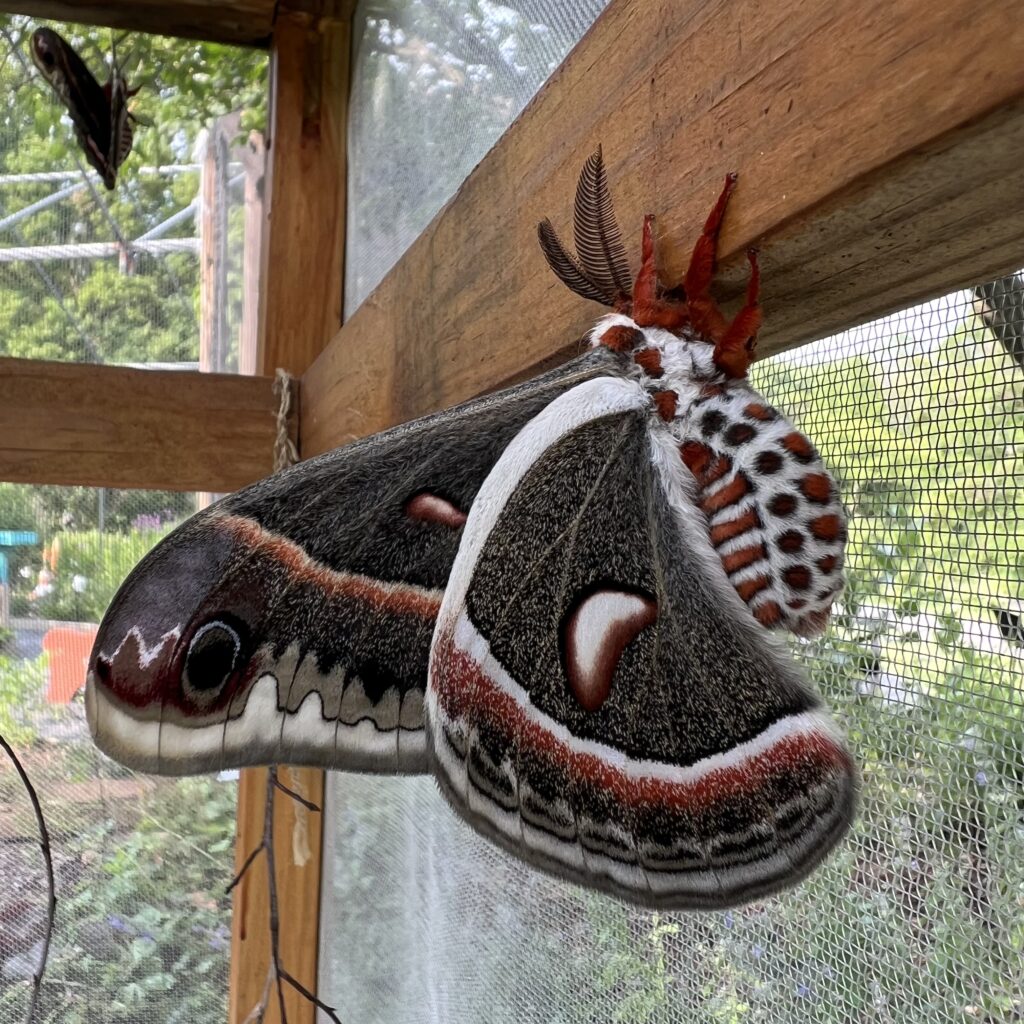
Cecropia moth (Hyalophora cecropia)
With a wing span of over 7”, cecropias are the largest moth in North America. Their lives as adults are so short, 10 to 14 days, that they do not even have working mouth parts! The moths eclose in the morning and start pumping fluid into their wings. They will make their first flight after dark. The male will use his large feathery antennae to detect female pheromones over a mile away. Look for the caterpillars on the cherry tree in the Pollinator Preserve in July and August. They are bright green and grow to the size of a hotdog! If you’re quiet, you can actually hear them eating. You can read about their full life cycle here.
Location: Pollinator Preserve rearing cage (the cage is open so the moths can leave to complete their life cycle).

Red milkweed beetle (Tetraopes tetrophthalmus)
Look at the head of this beetle and you’ll see it has 4 eyes. The antenna bisect the eye splitting it into two. I cannot fathom what evolutionary advantage this allows. It’s most bizarre.
Location: On milkweed wherever it grows.

American nursery web spider with egg sac (Pisaurina mira)
Female nursery web spiders carry their egg sac by grasping it with their fangs and securing it to their body with silk. When the egg is ready to hatch, the female constructs a nursery by gathering leaves together with webbing and hangs the egg inside. The mother stays nearby to defend the egg. She will remain with the spiderlings until their first molt. After their first molt, the spiderlings leave the nursery and head out on their own. When I found this spider on Wednesday, she was just starting to construct the nursery. By Saturday afternoon, the nursery was so thick with webbing she was barely visible. I was hoping to see the egg hanging in the nursery, but she was still clutching it.
Location: Pollinator preserve and in the cup plants behind Lucille’s Garden.

Sweet bay magnolia (Magnolia virginiana)
These large flowers have a delightful scent.
Location: On the left before the pond bridge.



